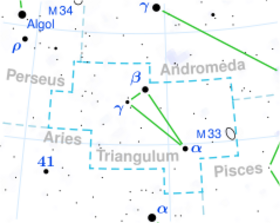Astronomy:5 Trianguli
| Observation data Equinox J2000.0]] (ICRS) | |
|---|---|
| Constellation | Triangulum |
| Right ascension | 02h 11m 25.02s[1] |
| Declination | +31° 31′ 35.02″[1] |
| Apparent magnitude (V) | 6.23±0.01[2] |
| Characteristics | |
| Spectral type | A0 Vm[3] |
| U−B color index | +0.11[4] |
| B−V color index | +0.12[4] |
| Astrometry | |
| Radial velocity (Rv) | 7.7±1.5[5] km/s |
| Proper motion (μ) | RA: +35.429[1] mas/yr Dec.: −10.785[1] mas/yr |
| Parallax (π) | 8.1779 ± 0.0862[1] mas |
| Distance | 399 ± 4 ly (122 ± 1 pc) |
| Absolute magnitude (MV) | +1.07[6] |
| Details[7] | |
| Mass | 2.22±0.41 M☉ |
| Radius | 2.96±0.36 R☉ |
| Luminosity | 48.2±1.2 L☉ |
| Surface gravity (log g) | 3.84±0.31 cgs |
| Temperature | 8,836 K |
| Metallicity [Fe/H] | −0.17[8] dex |
| Rotational velocity (v sin i) | 15±10[9] km/s |
| Other designations | |
| Database references | |
| SIMBAD | data |
5 Trianguli is a solitary star located in the northern constellation Triangulum. With an apparent magnitude of 6.23,[2] it’s barely visible to the naked eye under ideal conditions. The star is located 399 light years[1] away from the Solar System, but is drifting away with a radial velocity of 7.7 km/s.[5]
5 Trianguli has a classification of A0 Vm,[3] which states it’s an A-type main-sequence star with unusually strong metallic lines. It has 2.22 times the mass of the Sun and 2.96 times the radius of the Sun. 5 Trianguli radiates at 48 solar luminosities from its photosphere at an effective temperature of 8,836 kelvin, which gives it a white-hue of an A-type star.[7] It has a low projected rotational velocity of 15 km/s, common for Am stars.[9]
References
- ↑ 1.0 1.1 1.2 1.3 1.4 1.5 Brown, A. G. A. (August 2018). "Gaia Data Release 2: Summary of the contents and survey properties". Astronomy & Astrophysics 616: A1. doi:10.1051/0004-6361/201833051. Bibcode: 2018A&A...616A...1G. Gaia DR2 record for this source at VizieR.
- ↑ 2.0 2.1 Høg, E.; Fabricius, C.; Makarov, V. V.; Urban, S.; Corbin, T.; Wycoff, G.; Bastian, U.; Schwekendiek, P. et al. (March 2000). "The Tycho-2 catalogue of the 2.5 million brightest stars". Astronomy and Astrophysics 355: L27–L30. ISSN 0004-6361. Bibcode: 2000A&A...355L..27H.
- ↑ 3.0 3.1 Palmer, D. R.; Walker, E. N.; Jones, D. H. P.; Wallis, R. E. (1968). "The radial velocities spectral types and projected rotational velocities of 633 bright northern A stars.". Royal Greenwich Observatory Bulletins 135: 385. Bibcode: 1968RGOB..135..385P.
- ↑ 4.0 4.1 Sato, K.; Kuji, S. (November 1990). "MK classification and photometry of stars used for time and latitude observations at Mizusawa and Washington.". Astronomy and Astrophysics Supplement Series 85: 1069. ISSN 0365-0138. Bibcode: 1990A&AS...85.1069S.
- ↑ 5.0 5.1 Gontcharov, G. A. (November 2006). "Pulkovo Compilation of Radial Velocities for 35 495 Hipparcos stars in a common system". Astronomy Letters 32 (11): 759–771. doi:10.1134/S1063773706110065. ISSN 1063-7737. Bibcode: 2006AstL...32..759G.
- ↑ Anderson, E.; Francis, Ch. (May 2012). "XHIP: An extended hipparcos compilation". Astronomy Letters 38 (5): 331–346. doi:10.1134/S1063773712050015. ISSN 1063-7737. Bibcode: 2012AstL...38..331A.
- ↑ 7.0 7.1 Stassun, Keivan G. et al. (September 2018). "The TESS Input Catalog and Candidate Target List". The Astronomical Journal 156 (3): 102. doi:10.3847/1538-3881/aad050. ISSN 0004-6256. Bibcode: 2018AJ....156..102S.
- ↑ Anders, F. et al. (1 August 2019). "Photo-astrometric distances, extinctions, and astrophysical parameters for Gaia DR2 stars brighter than G = 18". Astronomy and Astrophysics 628: A94. doi:10.1051/0004-6361/201935765. ISSN 0004-6361. Bibcode: 2019A&A...628A..94A.
- ↑ 9.0 9.1 Abt, Helmut A.; Morrell, Nidia I. (July 1995). "The Relation between Rotational Velocities and Spectral Peculiarities among A-Type Stars". The Astrophysical Journal Supplement Series 99: 135. doi:10.1086/192182. ISSN 0067-0049. Bibcode: 1995ApJS...99..135A.
 |


